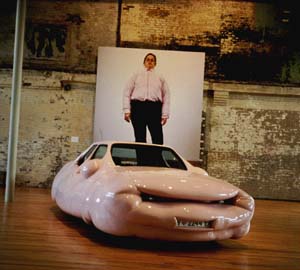fishing
I suppose blogging is kind of like fishing – you never know who will nibble. I was so-o-o excited to be linked to by a website on underwater sound; specifically in their underwater *sound fixing and ranging * (SOFAR) pages. Check out the high speed videos of snapping shrimp, which document how shrimps make snapping sounds through *cavitation bubbles*
And speaking of *snapping*, what is *up* with consensual cannibalism? Is it just me or is this the weirdest thing to come down the BBC news pipe for a long time? There’s something about the *juxtaposition* of those two words. Apparently, Armin Meiwes, the German who is standing trial for eating an acquaintance, has advised others not to follow his example. Well . . . . All right then!
The Austrian artist Ervin Wurm frequently riffs on these strangely Germanic notions of engulfing and bloating. I caught a show of his last year at MassMoCA and snapped this pic of one of his installations.

Erwin Wurm installation
One of my great pleasures (when I occasionally get off of my *tiny windswept island*) is to be able to power-watch piles of DVD’s of films that I missed, when they were theatrically released. To do this, I have to travel to Victoria. Most of the other towns between here and there are grim industrial sorts of places, which look like they’ve been ‘twinned’ with Vladivostock (say) or Novosibirsk. Their skylines consist of enormous pulp mills, spewing vast plumes of carcinogenic smoke into the local airsheds, surrounded by mountains that look like they are coming out of chemotherapy- their forests torn off in huge patches of clearcut logging.
Victoria on the other hand is affectionately known as “the tweed curtain” due to to its oddly endemicized anglophilia. More like Torquay than BeeCee, Victoria boasts a peculiarly temperate microclimate, replete with palms and eucalyptus trees, which look rather dissonant within the context of the outwardly nordic landscape.
This virtual England also has double-decker buses and an enormous population of retirees.

Chinese fan palm in Victoria BC
A trip to the local independent video store yielded a couple of gems: Agnes Varda’s (2000) documentary paean to food recycling called ‘The Gleaners’ as well as Wang Xiaoshua’s (1998) bleak Chinese noir film, ‘So Close to Paradise’. Varda of course is the doyenne of the French nouvelle vague and ‘The Gleaners’ represents a later stage work, which is both sentimental and fascinatingly tangential. For example, Varda works a narrative about Etiene-Jules Marey, the French father of chronophotography (predating Edvard Muybridge) into a story about finding discarded heart-shaped potatos at a dump. Varda comes across as a kinder, gentler more humanistic Chris Marker but she shares his overt intimacy with the camera (which almost becomes a character in their films) and they both track discursive narratives relentlessly and unapologetically. Varda (like Marker) is truly a blog filmmaker. And they both like cats . . . .
Wang Xiaoshua (one of the PRC’s so called ‘sixth generation’ filmmakers) has produced, in ‘So Close to Paradise’ (and later, ‘Beijing Bicycle’), films that ‘out noir’ NOIR, yet don’t lapse into the stultifyingly puerile hystrionics of Quentin Tarantino and his ilk. Tarantino’s work can’t hold a candle to that of Xiaoshua’s or Hong Kong’s Wong Kar-Wai (who made Chungking Express, Fallen Angels etc.) – and what is even *more* amazing is that Xiaoshua was able to make his films in a climate of strict censorship and repression. ‘So Close to Paradise’ was banned by Chinese censors for 3 years because of its portrayal of the problems facing modern China, yet Xiaoshua still managed to move doggedly forward, making films under a pseudonym. The film scene in China is full of such fascinating, hard-core auteurs and I vowed to waste no more time watching the lame and bloated offerings of an increasingly irrelevant Hollywood.
I recall seeing a panel discussion at the Hawaii International Film Festival in 1995, where Zhang Yimou, Hou Hsiao-Hsien and several other PRC filmmakers were being pressed by sycophantic American journalists to admit ‘how hard it must be to work under state censorship’ without the ‘freedom’ enjoyed by American filmmakers. The filmmakers replied (and I’m paraphrasing here) that, while their situation in China was not without enormous challenges, at least they weren’t burdened by the censorship of the North American marketplace, where it has become nearly impossible to raise money for any major project that isn’t completely banal and formulaic.
And speaking of formulas: the BBC’s Earth Report ran a story recently which examined the correlation between environmental degradation and genocide in Rwanda and elsewhere. In the program, Mark Halle (Project Coordinator of Environment and Security at the International Institute of Sustainable Development) said:
“We did a very interesting case study in Rwanda, looking at the origins of the genocide in 1994 and in fact we found that there was a perfect correlation those parts of the country that were most degraded and the areas where the conflict originated. Now that’s not to say that environment was the cause of the Rwandan genocide. But it’s certainly a contributing factor.”
Earthwatch goes on to say:
The link between environmental degradation and global security has become such a pressing issue that the United Nations Environment Programme and the United Nations Development Programme are working on a joint project with two bastions of international security: the Organisation for Security and Cooperation in Europe, and NATO. The result of this partnership is the Environment and Security Initiative, known as ENVSEC. Its working on a pilot project in Central Asia and South Eastern Europe – a region where resource scarcity, ethnic tension and weak civil society have combined all too frequently to spark off conflict.
Earth Report closes with some footage of abandoned fishing boats resting on the dry bed of the now vanished Aral Sea. From this *single biggest environmental catastrophe on the planet*, blow clouds of pesticide contaminated dust, causing an epidemic of anemia, liver and thyroid disease as well as cancer, giving the area the highest child mortality rate in Russia. The image of sick and impoverished Cental Asian children playing among stranded fleets of rusting fishing vessels, in the middle of this vast, man-made desert, is for me one of the defining icons of the failure of modernity.



